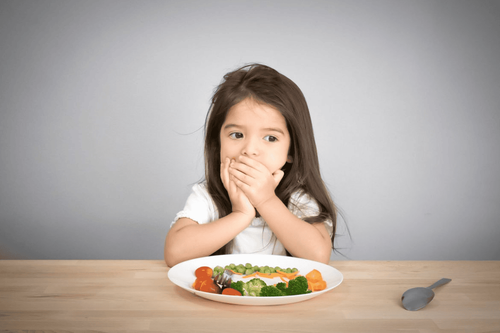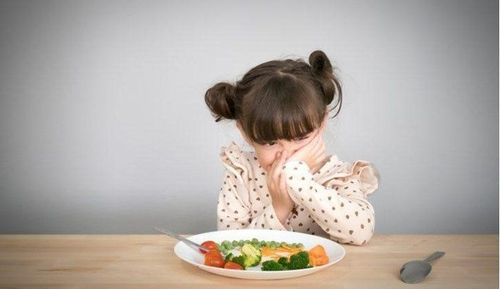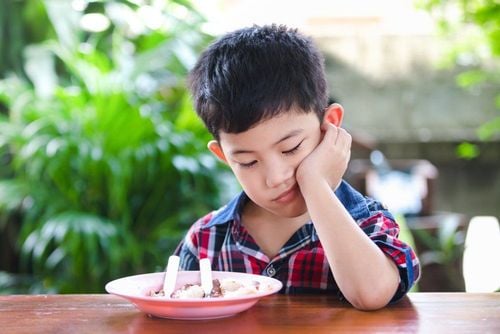This is an automatically translated article.
Physiological anorexia is a common condition when children enter different stages of development of the body. Physiological anorexia usually occurs in a short time, with few serious consequences. However, if parents do not pay attention or handle it improperly, this situation can turn into anorexia nervosa, which is difficult to overcome.
1. What is anorexia physiological?
Children with anorexia are divided into 3 types: psychological anorexia, pathological anorexia and physiological anorexia. Physiological anorexia is a condition in which a child suddenly loses his or her appetite or eats less than usual. The time of physiological anorexia of children usually takes place in 1.2 days or lasts up to 1-2 weeks depending on the stage. They can happen many times or repeat during the process of development, natural physical changes such as: teething, weaning, talking, walking...
Parents if they see young children If there are the following signs, it is likely that the child has a physiological anorexia:
Sudden anorexia: Physiological anorexia in infants is expressed in the fact that the child sucks less than usual, does not actively ask for milk. , even refused to breastfeed. For children who are weaning, their food intake is very small, they almost do not want to eat anything (even their favorite foods), or only choose to eat certain foods, do not want to try new foods. Children suck food, lazy to swallow: Some children have an uncooperative attitude, holding food in their mouths for a long time. Even crying, spitting food out and refusing to swallow... Meals can last up to hours in the fatigue of both mother and baby. Naughty children, do not pay attention to eating: at the stage of crawling and learning to walk, most children are hyperactive, like to discover new things from the surrounding environment. Therefore, children often refuse to sit still during each mealtime. Many children even forget to eat while playing, or even if they eat, they don't pay attention, completely ignoring when their mother feeds them. In general, physiological anorexia does not leave serious consequences. Most of the time, after the body has adapted to the transition periods, children will return to eating and drinking normally. However, parents should note that if physiological anorexia lasts for more than 1 month, it will affect the health and development of the child, at this time it is necessary to have close monitoring and appropriate handling.

Trẻ đột ngột biếng ăn là một trong các dấu hiệu của biếng ăn sinh lý ở trẻ sơ sinh
2. Physiological anorexia stages of children
In general, the child's physiological anorexia time can be divided as follows:
Stage 3 - 4 months old: The time when the child begins to roll over, raise his head, observe and explore the surrounding environment Stage 6 months: when babies transition to a new diet, weaning and getting used to a variety of new foods. The period from 9 to 10 months old: At this time, children begin to learn to crawl, learn to stand, and learn to walk, so meals will no longer be as attractive and stimulating as before. This is also the time when children start teething, causing pain or fever, fatigue, discomfort and loss of appetite. The period from 2 to 3 years old: is the time when children have started going to kindergarten. Changing the living environment and diet has a significant impact on children's psychology, making them prone to anorexia.
3. How to handle physiological anorexia in children
Physiological anorexia is completely normal and occurs in most young children due to physiological changes during development. At this stage, children need time to adapt to the changes in their body, so parents should not be too worried. However, in order for the child's physiological anorexia weeks to pass more smoothly, parents can apply the following measures:
Split meals: increase the number of meals a day and reduce the amount of food in each meal. , each time feed the child little by little. Both ensure nutrition and make children not feel "crammed" with too much food. Increase the amount of milk and snacks if needed: If the child does not eat much in the main meal, parents can give the child extra cheese, yogurt, cookies, flan, fruit... Priority is given to soft foods. , liquid, easy to digest: For example, soups, soups, porridge, broken rice eaten with eggs, fish... or other favorite dishes of children every day. Presenting food attractively and beautifully: helps stimulate the taste buds, making children want to explore and enjoy eating more. Direct children's focus on meals: do not let children watch TV, phones, ipads... while eating, but help children focus on eating and completing the meal in 30-40 minutes. Do not threaten or scold to force food: If the child has an uncooperative attitude and refuses to eat, the mother should be more patient. Coercive actions can make children more afraid of eating, turning into a long-lasting psychological anorexia that is difficult to overcome. Instead, parents should behave comfortably at each meal, help children adapt to the new stage of physical development, and soon children will eat as well as before.

Khắc phục thời gian biếng ăn sinh lý của trẻ với cách trình bày món ăn hấp dẫn
In addition to improving anorexia, the baby also needs to add the necessary micronutrients: Zinc, selenium, chromium, Vitamins B1 and B6, Ginger, acerola fruit extract (vitamin C),... to improve taste, eat well, reach the correct height and weight, and exceed the standard, have a good immune system, strengthen the resistance to get sick less often and have less digestive problems.
In general, with physiological anorexia parents do not need to worry too much. Just be subtle and observe the child a little more closely, the physiological anorexia in children will quickly be noticed and promptly overcome.
With many years of experience in examining and treating diseases in children, now the Pediatrics Department at Vinmec International General Hospital has become one of the major health care centers, capable of examining , screening and treatment of many specialized diseases in children. Therefore, if the child has health problems, parents can take the child to Vinmec International General Hospital for examination and receive support and advice from doctors and nutritionists.













